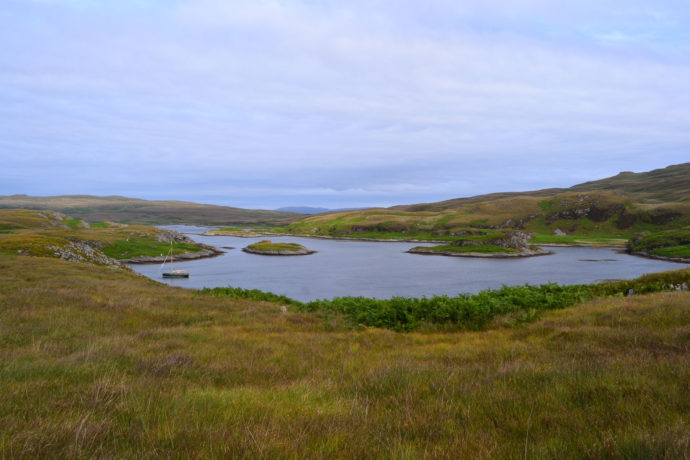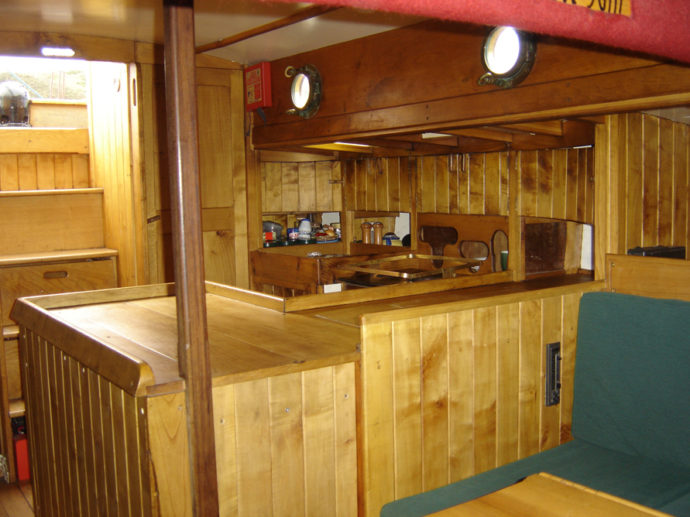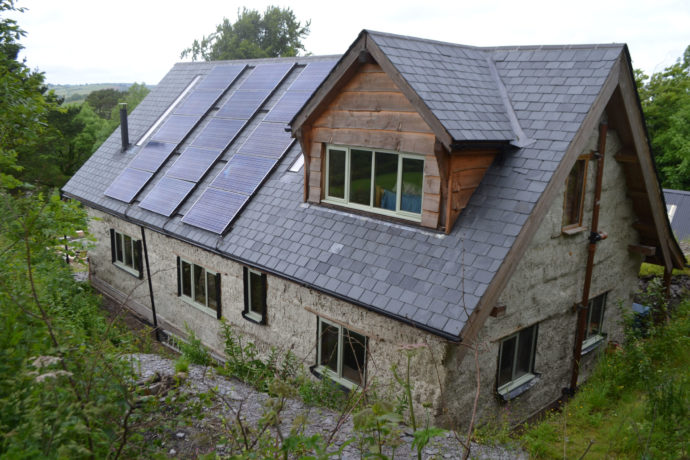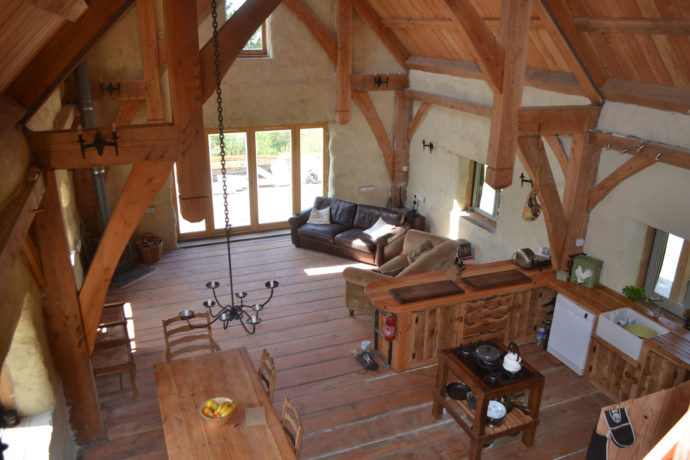
Because our house is powered entirely by the sun, located on Exmoor, in the UK (an area noted for its ‘weather’), I wondered if now – with the mid-summer solstice just days away – might be a good time to review how our off-grid Photovoltaic system is working-out?
I’ve mentioned elsewhere that Linda, my wife, and I lived on board a sailing boat for seven years, often in the wilderness, miles from civilization. That lifestyle taught us to consume everything moderately, because everything we used had to be replaced. Importantly – and this is a seemingly small point – but importantly we consumed our stores according to their abundance …or scarcity.
Years later when we decided to build ourselves a straw bale house (as you do) it seemed natural to be ‘off-grid’ for water, waste and electricity …to be entirely independent, and bill-free. And it seems natural to adjust our daily activities according to the resources available to us. I talk in a minute, for example, about using the washing machine only in conditions of bright sunlight – but I want to stress that that isn’t a hardship or an inconvenience, but a habit as automatic to us as breathing, bathing, daddy-dancing round the room when an old song comes on the radio, or talking to the dog as though he speaks English.
Exmoor is hilly with some parts receiving 2 metres of rain annually – at our precise location it’s about 1.3 metres and our domestic fresh water, which is fed by a spring, seems to be holding up quite well. The initial collection point for this water, before it travels under the force of gravity down a pipe to a 2000 ltr underground tank, is essentially a fresh-water rock-pool and needs to be cleared of its choking mass of blanket weed at this time of year. In order to lift the water from the underground tank, and to supply pressure at the outlets, the water is pumped. The 1 kWh intermittent load placed on our off grid electricity supply by the pump is negligible in terms of energy usage.

Exmoor. Courtesy: Ruth Sharville.
Waste water goes to a private treatment plant – also travelling under the force of gravity. The treatment plant operates by pumping air into the tank and releasing it at the bottom of an open-tube which constantly refills with ‘grey’ water. The bubbles force water up the tube where it is thrown, sprinkler fashion, onto a matrix of plastic mesh – the idea being to maximise exposure to oxygen and encourage the growth of neutralising bacteria. The unit consumes 40 watts, constantly.
All lighting in the house is provided by LED bulbs. If we turned all our lights on at the same time they would consume just over 300 watts – but we don’t do that because the ‘wattage equivalent’ of those LED bulbs is over 3.5 kW. We tried turning all the lights once, but found we had to wear welding masks. Typically we use 40 watts of lighting at any one time.
The machine on which I write these words consumes 150 watts and is on for 8 – 10 hours daily.
The largest continual load we place on our electrical system is the fridge/freezer at 100 watts. I thought the fridge/freezer would run intermittently …thermostatically switching itself off-and-on – but it doesn’t. Perhaps it’s not a very good appliance? …poorly insulated, inefficient at radiating heat from its compressed gas? If you turn the unit around and have a look at the back there’s a pipe coming from the compressor which is always covered in snow – in spite of the room temperature being +20℃. And its ‘radiator’ is too close to the sheet of insulation which is glued to the back of the fridge – it feels too hot considering that the cool compartment is less than 25mm away. The appliance draws 100 watts x 24 hours = 2.4kWh/day. So at 876kWh per year it consumes more than 4 times as much energy as might be expected from an A++ rated appliance. Also, because it’s a ‘cabinet’, when you open the door the ‘coolth’ falls out. We’re considering buying an A++ rated chest freezer (top-opening) – yet running it as a fridge by changing the thermostat to one which can be set at + 1℃ / + 4℃. Alternatively we may abandon the fridge altogether in favour of an outdoor larder – set perhaps into the always-damp excavated rock-face at one end of the house (our house is built on a very steep hill). We don’t plan to run the fridge during the winter because then the world is the fridge.
The washing machine peaks at 2kWh, the water pump adds 1kWh, the vacuum cleaner another 1kWh, plus ancillary items at 300Wh – all easily taken care of by our Multiplus 5000 Inverter/Charger which can provide up to 5kVA. All these conveniences are the more easily provided with electricity from our AGM battery bank (48v/440Ah) because, as mentioned earlier, we only use them when the sun is out. The same is true for the dishwasher – though with just the two of us we tend to wash up in the sink, by hand. In fact we find we make a lot of decisions according to the weather – so that sunny days are more likely to find us eating toast for breakfast instead of cereals; using the vacuum cleaner instead of a broom; or using the hairdryer instead of driving up the road with the windows open.
So why all this fiddling around – trying to make tiny savings here and there?
Our Photovoltaic panels were commissioned during the last week of January – four and a half months ago – and since that time have yielded 440kWh of electricity …that’s an average of just 3.3kWh per day. This probably sounds very amateurish – but we try to keep the battery SOC above 90% in the belief that they will have a longer life if they’re not deeply cycled. Our panels, then, could have yielded more but because our battery bank is often at or around 100% SOC our MPPT 150/100 Charge Controller reduces the demand from the panels to prevent overcharge, and therefore our ‘total yield’ is lower than if the batteries were always partially discharged.
Having said that I’ve never seen our 4kW peak panels deliver more than 2kW, and I’m beginning to wonder if they need a clean. I’m going to buy one of those telescopic water/brush things that window-cleaners use – I’ll let you know if it makes any difference.
I’m writing these words on a sunny morning in June, it’s ten-thirty, three of the fifteen panels are in un-broken sunlight, the rest have shadows flitting over them – cast by the leaves of a near-by tree. That tree didn’t have it’s leaves back in January when on sunny days the panels’ peak performance was equal with the peak performance we get now summer has arrived. By lunchtime all the panels will have an un-interrupted view of the sun (if it’s still shining) and for the three or four hours after that they’ll produce their best results. I must admit I’m surprised those panels don’t perform better on an overcast day …though perhaps that’s more about managing my expectations than any fault on the part of the panels. At around lunchtime yesterday, when it was very windy and sunny at the same time, UK energy generation from ‘renewables’ – for the first time ever – accounted for more than half of all electricity generation (51.7%) at 18.7GW. Wey hey!
Looking back over the last five months, our lifestyle seems to suit the PV system quite well. I notice that since January 25th we have run the generator just twice, for a total of 100 minutes.
I should add that when it’s sunny we have more electricity than we know what to do with. Well – we do know what to do with it …Phil Smith from Barden UK is going to program the Color Control to ‘dump’ excess energy into our hot water cylinder. I’ll let you know how we get on when that cleverness is up and running.
Speaking of record breaking energy generation, have you visited the Victron Remote Management portal? From there you can try the VRM demo if you don’t already have a VRM account, plus you can get access to real-time and historic energy/generation data for installations all over the world. You can find our installation on VRM World by searching for: Straw Bale House or by simply using this direct share link:
https://vrm.victronenergy.com/installation/10464/share/2218d59f
You can learn more about VRM World at:
https://www.victronenergy.com/live/vrm_portal:vrm_world


















 #victronenergy #adventure
#victronenergy #adventure
 ELECTRICS
ELECTRICS 
